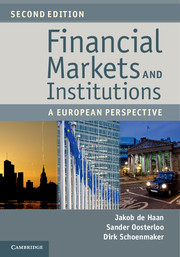Book contents
- Frontmatter
- Contents
- List of Boxes
- List of Figures
- List of Tables
- List of Countries
- List of Abbreviations
- Preface
- Part I Setting the Stage
- Part II Financial Markets
- Part III Financial Institutions
- Part IV Policies for the Financial Sector
- Chapter 12 Financial Regulation and Supervision
- Chapter 13 Financial Stability
- Chapter 14 European Competition Policy
- Index
- References
Chapter 12 - Financial Regulation and Supervision
from Part IV - Policies for the Financial Sector
- Frontmatter
- Contents
- List of Boxes
- List of Figures
- List of Tables
- List of Countries
- List of Abbreviations
- Preface
- Part I Setting the Stage
- Part II Financial Markets
- Part III Financial Institutions
- Part IV Policies for the Financial Sector
- Chapter 12 Financial Regulation and Supervision
- Chapter 13 Financial Stability
- Chapter 14 European Competition Policy
- Index
- References
Summary
Overview
This chapter reviews the reasons for regulation and supervision of financial services. Regulation refers to the process of rule making and the legislation underlying the supervisory framework, while supervision refers to monitoring the behaviour of individual firms and enforcing legislation. The case for government intervention is based on market failures. A first market failure is rooted in asymmetric information: financial institutions are generally better informed than their customers. A second market failure is externalities: the failure of a financial institution may affect the stability of the financial system as a whole. A third market failure occurs when certain players in the market exert undue market power.
The chapter discusses financial supervision in more detail, distinguishing between prudential supervision and conduct-of-business supervision. Prudential supervision aims to protect consumers by ensuring the safety and soundness of financial institutions. As financial institutions are becoming more complex, supervisors are moving away from direct control to methods that provide incentives for financial institutions to behave prudently. Conduct-of-business supervision focuses on how fi nancial institutions deal with their customers and how financial institutions behave in markets. For instance, information provisions aim to ensure that consumers get the right information about financial products. In addition, there are guidelines for objective and high-quality advice to protect the interests of customers. Conduct-of-business rules also promote fair and orderly markets.
- Type
- Chapter
- Information
- Financial Markets and InstitutionsA European Perspective, pp. 361 - 391Publisher: Cambridge University PressPrint publication year: 2012



